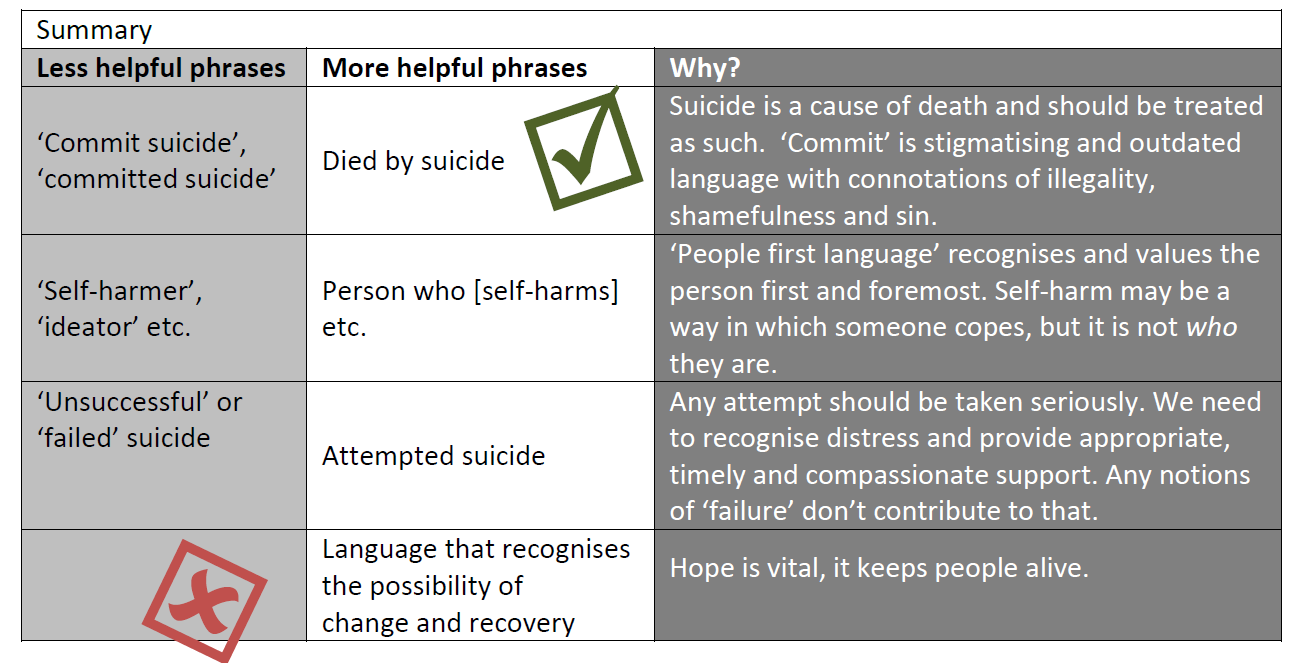What’s in a Word? The Language of Self-harm and Suicide (and why it matters)
Suicide is complex, but helping to prevent suicide doesn’t have to be. Everyone has a role to play and there are some seemingly small changes, that we can all make, that have a big impact. Thinking about the language that we use can do just that. While our language can convey compassion, provide hope, empowerment and optimism, we can also unwittingly express messages that divide and stigmatise. This blog post by Emma Nielsen discusses how even everyday expressions may carry connotations we have not considered and speak to ideas we don’t condone.
The term ‘committed suicide’ has perhaps prompted the most publicised opposition. Although commit can mean a number of things, if we think about other times we use the word, it tends to be associated with negativity and wrong-doing. People commit crimes. People commit moral atrocities. People die by suicide. While opinions about suicide vary, we don’t usually associate the term commit with a public health concern, or mental health tragedy and the phrase goes no way to acknowledging the turmoil faced by someone prior to taking their life. Historically, suicide was deemed a crime. Not anymore (not since 1961 in the UK). While we’ve updated our legislation appropriately, we haven’t updated our language; suicide is a cause of death and our language should reflect this. In no other situation would we say that someone committed their death, regardless of any personal or lifestyle factors which may have contributed to the outcome. Stigma can be life-changing and life-limiting. Research shows that stigma makes people less likely to ask for help and also less likely to get it. For survivors of suicide loss, it can be insensitive language which amplifies the distress of an already difficult situation.
Stigma can be life-changing and life-limiting. Stigma is also faced by those who have experiences around self-harm. Stigma comes in many forms. Overtly, self-harm is often wrongly dismissed as ‘manipulative’ or ‘attention seeking’. More subtly, phrases like ‘self-harmers’, ‘cutters’ and ‘ideators’ (describing people who have thought about harming themselves but have not acted on these ideas) are also difficult for many. Language here could be seen as dismissive and pejorative. Some feel such terms take away from individual identity; typically, self-harm affords people a means of dealing with intolerable (and often deeply distressing) emotions. It may be someone’s coping response. It is not who they are. Being respected and valued first and foremost as an individual is important to wellbeing. Because of this, many prefer for the use of ‘people first language’. That is to say, to talk about ‘people who self-harm’, rather than ‘self-harmers’. People first language also means that we can use our words more accurately; unlike phrases like ‘self-harmer’, person first phrasing can easily accommodate information about recency (e.g., in the last 6 months) and frequency (e.g., more than 5 times) etc. Here, language matters as it helps to shape our attitudes and ideas. These phrases acknowledge the possibility of recovery. These things are really important as the possibility of change is laced with hope. And hope is vital. Hope keeps people alive.
Of course, everyone is different. People are comfortable with different words and phrases and everyone should be free to tell their story in their own words. We can’t know what each person will prefer, but we can all do our best to ensure that our words don’t build unintentional barriers that exclude those who most need to be heard. We need to open up conversations with people if we are worried about them. And we need to make sure that the language we use when doing so is informed and hopeful. We have an opportunity to lead by example, to consider the choices we make and to politely and helpfully challenge those around us. We can all play a role in suicide prevention. Starting with such small and simple changes, that’s quite something…
Further information and great advice for media reporting of suicide can be found:
http://www.samaritans.org/media-centre/media-guidelines-reporting-suicide
http://www.mindframe-media.info/for-media/reporting-suicide
. . . . . . . . . . . . . . . . . . . . . . . . . . . . . . . . . . . . . . . . . . . . . . . . . . . . . . . . . . . . . . . . . . . . . . . . . . . . . . . . . . . . . Emma Nielsen is a PhD student in the Self-Harm Research Group, University of Nottingham. She can be contacted at emma.nielsen@nottingham.ac.uk or connected with on Twitter at @EmmaLNielsen. This blog post was originally written for the Institute of Mental Health blog and adapted for PAPYRUS.
Nielsen, E., Padmanathan, P., & Knipe, D. (2016). Commit* to change? A call to end the publication of the phrase ‘commit* suicide’. Wellcome Open Research, 1, 21. doi: 10.12688/wellcomeopenres.10333.1

